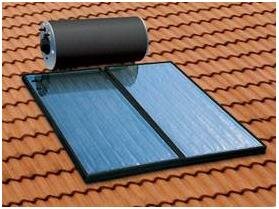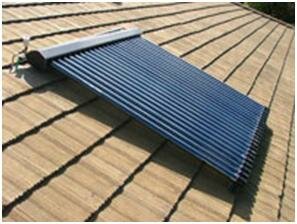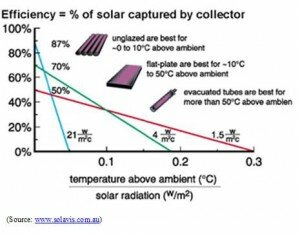Which Solar Hot Water Heating System?
(Part Two) The first part of this topic was published on the 8th of May.
Flat Plate Solar Collectors
Flat panel (aka flat plate) collectors work on the principle of copper pipes running through a glass covered collector, often connected to a water storage tank on the roof. The hot water can then thermosiphon itself in and out of the tank, thus heating the water. Finally the hot water is gravity fed into the house from the roof. This is an extremely efficient way of gaining and storing hot water and can be over 90% efficient in the right climate. The simplest combination is the close-coupled system (see photo below).
However, the water tank may be located in the roof space or on the ground as a separate unit in which case a pump is necessary to circulate the water. This is known as a split system. Flat panel collectors are still the most commonly used collectors in domestic hot water applications in warmer climates due to their affordability and reasonably easy installation. The collectors should last well over 20 years and can handle an operating temperature up to 80 degrees.
Evacuated Tube Solar Collectors
Evacuated tube collectors consist of glass tubes with a layer of heat absorbent coating inside them. As the tubes encasing the water pipes are a vacuum it greatly reduces heat loss. The thermal energy retention can be up to 97%. Copper pipes run through the centre of these evacuated glass tubes in a U-shape. These are all connected to a common manifold which is then connected to a slow flow circulation pump which pumps water to a storage tank below. The hot water can be used at night or the next day due to the insulation of the tank. Evacuated tubes are often used in commercial applications or in applications where hotter water is needed, since they are capable of generating temperatures above the boiling point of water (for example on dairy farms). While evacuated tubes have a long life similar to flat plate collectors, they are composed of fragile glass tubes which may occasionally need replacement.
Comparisons
As pointed out in Part One of this blog it is not a simple matter of using evacuated tubes or flat panels as each circumstance is different. Each collector design has its own merits. Both systems can save over 3 tonnes of GHG emissions per year and can reduce heating energy consumption in a home between 50% to 80% especially when electric hot water storage systems are being replaced. In addition both systems can be up to 70% efficient when heating water and heat losses in the system are taken into account. So instead we should look at the benefits and the short comings of each system.
Evacuated Tubes
Advantages
- No heat losses due to convection and conduction because glass collectors are hermetically sealed.
- No change of performance during the service life of the collectors as there is no corrosion.
- Thermal diode operation principle, the hot water flows one way only from the collector to the tank and never the other way around.
- It is able to harness sunshine from all directions due to its cylinder-shaped glass tubes.
- Well-suited for colder climates with reduced hours of sunshine, where frost may be a problem or where the roof is prone to overcast from clouds.
- Freeze free so can be used in sub-zero temperatures and in the presence of snow.
- Easy installation due to light weight and no maintenance needed afterwards.
- Requires smaller roof area for installation.
- It is less apparent on roof because of the absence of a water tank coupled to it.
- Each glass tube is independent from each other so in case of breakage it can be replaced.
- Minimum greenhouse emissions when combined with gas boosting.
- Saves about 3 tonnes of CO2 annually when compared to electric storage.
- Very low running cost when used with gas or off peak electricity.
- On average it is about 5 years payback on investment.
- Suited for commercial and industrial applications.
Disadvantages
- Expensive to purchase due to more components, such as pump, separate water tank and associated plumbing and electrical work.
- Less cost effective than flat panels based on initial investment.
- Glass tubes could break easily in a hail storm or from falling branches.
- In higher ambient temperatures it is less efficient than flat panels.
- In direct summer sun it could be too efficient making the water too hot which results in wastage.
- Evacuated tube collector’s aperture area is typically between 60 and 70% of the gross collector area (meaning that’s how much of the total area exposed to sun is doing useful work).
- Some heat pipes are prone to cracking rendering the system useless especially at the braising points. These don’t like repeated heating and cooling down especially if it is very sudden.
- The welding should be done with silver alloys to prevent this from happening.
- Mainly made in China, thus not supporting Australia.
Flat Panels
Advantages
- Operates extremely efficiently in warmer climates and in higher ambient temperatures especially when water tank is horizontal and adjacent to the collectors.
- It can be between 44% to 76% more cost effective in warm climates than evacuated tubes.
- Losses are minimised because of water tank being located next to collectors.
- Thermosiphon operation minimises maintenance - no moving parts or distant pipes.
- Simple to install as system can be purchased as one unit with collectors and tank together.
- Affordable to purchase for the above reasons and because of less plumbing involved.
- No electrical installation required in most cases where stand alone system is used (ie the tank is not separate from the collectors).
- Space saving as water tank is located on roof and not in or around the house.
- Robust construction.
- Large collector area.
- Flat plate collector’s aperture area is typically between 90 and 95% of the gross collector area.
- Mostly made in Australia for Australian conditions, which supports the local industry and economy.
Disadvantages
- Can corrode.
- The air gap between the absorber and cover pane could result in heat losses during cold and windy days.
- It can rob the water of built up heat if the collector becomes colder than the water temperature.
- No internal method of limiting heat build up and have to use outside tempering devices.
- In colder climates it may need extra protecting devices from frost or freezing.
- It is more reliant on accurate northern exposure in order to operate efficiently.
- Installation could be difficult due to weight and size.
- Circulates water inside insulated areas. Prone to leakage, corrosion and restriction of flow due to possible airlock.
The graph below compares the three main types of solar hot water systems and their efficiency.
Explanation: Solar collector efficiency is plotted as a straight line against the parameter (Tc-Ta)/I, where Tc is the collector inlet temperature (in °C), Ta is the ambient air temperature (in °C), and I is the intensity of the solar radiation (W/sq. m.). Notice that inexpensive, unglazed collectors are very efficient at low ambient temperatures, but efficiency drops off very quickly as temperature increases. They offer the best performance for low temperature applications, but glazed collectors are required to efficiently achieve higher temperatures.
Summary
From the above descriptions and considering the merits and drawbacks of each system the following conclusion can be drawn. In warmer climates and most temperate zones, where there is good exposure to sunshine throughout the year, and the ambient temperature is fairly stable the flat panel collectors are recommended to be used. Also, if there is good uninterrupted northern exposure available the flat panel is more economic. The flat panel is extremely efficient and the systems can produce sufficient hot water for most households. The use of a flat panel system will result in up to 80% reduction of hot water cost when compared to electric storage units. These are also more affordable with a faster payback period on investment. They are designed and made in Australia for Australian conditions.
On the other hand the evacuated tube systems have an advantage of being able to operate in colder climates or where there isn’t enough sun light (ie. some alpine or mountain areas, prone to overcast or where there are more trees). These systems also work well in the presence of snow or sub-zero temperatures. The unique design of the glass tubes allows it to capture sunlight from various angles thus heating the water for longer periods. In some cases where very high water temperatures are required - even in warmer climates- the evacuated tubes have the ability to produce water at higher temperatures than flat panels. Being smaller in surface area these units could be more suitable where there is a lack of space. Again 80% reduction in hot water cost and GHG emissions are quite achievable from such a system.
Please take note of the references for the graphs and information in this article. Where possible we have used information stemming from government websites, academic resources, and manufacturers data. If you need more information or actual references please contact us.
|
Wouldn't you like to HALVE this cost? AND do something to slow climate change... Delamping your fluorescent fittings is a simple, reliable, low-cost way of slashing your lighting energy costs - and greenhouse gas pollution. Click here to get your free report on how to delamp.
|
||
Tags: Add new tag, evacuated tube, flat panel, hot water, hot water efficiency, Solar hot water




 The average double fluorescent light fitting (probably like the one above your head right now) uses $800 of electricity over its life time.
The average double fluorescent light fitting (probably like the one above your head right now) uses $800 of electricity over its life time.
June 4th, 2009 at 10:16
I just hope that installations like these will get more affordable for people in the future. This way more people will be able to invest in systems like these which eventually will be better for the environment. The earth receives more energy from the sun in ONE hour then it uses in an entire year. Just to let you know that there are a lot of opportunities!!
June 9th, 2009 at 8:59
[...] Solar Hot Water » Blog Archive » Which Solar Hot Water Heating System? [...]